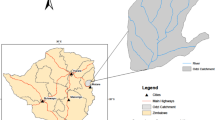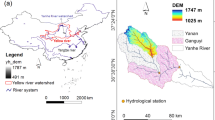Abstract
In the present work, a new simplified model approach for sediment delivery ratio (SDR) assessment is proposed. Modelling and assessing SDR is still an open question. Difficulties rise from the lack of sufficient data availability, on one side, and, on the other, from the inherent uncertainties including spatial variability and temporal discontinuity of the land cover, climatic, hydrological and geomorphological variables involved. The proposed SDRSIM model tries to skip over the limitations observed in other models generally adopted. A comparison with two different selected models amongst the most widespread simplified models, i.e. the area-model and the slope-model, is showed in application to a wide range of catchments extensions across different landscapes of Italy. The SDRSIM estimates were also evaluated against observed SDR over a validation dataset of 11 basins sparse over different regions of the world. The results showed the effectiveness of the proposed model approach based on easily available catchment parameters.



Similar content being viewed by others
References
Arnold JG, Williams JR, Srinivasan R, King KW (1996) The soil and water assessment tool (SWAT) User’s Manual. Temple, TX
Asselman NEM, Middelkoop H, Dijk PM (2003) The impact of change in climate and land use on soil erosion, transport and deposition of suspended sediment in the River Rhine. Hydrol Process 17:3225–3244
Bagarello V, Ferro V, Giordano G (1991) Contributo alla valutazione del fattore di deflusso di Williams e del coefficiente di resa solida per alcuni bacini idrografici siciliani (Evaluation of the Williams’s runoff factor and of sediment delivery ratio in some Sicilian river basins). Rivista di Ing Agr 4:238–251
Bazzoffi P, Pellegrini S, Chisci G, Papini R, Scagnozzi A (1997) Erosione e deflussi a scala parcellare e di bacino in suoli argillosi a diversa utilizzazione nella val d’Era (Plot and catchment runoff and erosion in clayey soils of Val d’Era, Tuscany). Agricoltura Ricerca XVIII(170):5–20
Bernard C, Laverdiwere MC (2001) Assessment of soil erosion at the watershed scale from 137Cs measurements. In: Stott RH, Mothar RH, Steinhardt GC (eds) Sustaining the global farm. USDA-ARS, USA, pp 1034–1038
Biagi B, Chisci G, Filippi N, Missere D, Preti D (1995) Impatto dell’uso agricolo del suolo sul dissesto idrogeologico. Area pilota collina cesenate (Influence of cultivations on hydrogeological equilibrium of soils). Collana Studi e Ricerche, Regione Emilia Romagna, Assessorato Agricoltura, Bologna, Italy, 153 pp
Bonora N, Immordino F, Schiavi C, Simeoni U, Valpreda E (2002) Interaction between catchment basin management and coastal evolution (Southern Italy). J Coast Res SI 36:81–88
Borselli L, Cassi P, Sanchis PS, Ungaro F (2004) Studio della dinamica delle aree sorgenti primarie di sedimento nell’area pilota del Bacino di Bilancino (Primary sediment sources in the Bilancino reservoir watershed area): BABI Project. Report of the Consiglio Nazionale delle Ricerche. Istituto di Ricerca per la Protezione Idrogeologica (CNR-IRPI), Florence Unit, «Pedologia Applicata», pp 104
Brath A, Castellarin A, Montanari A (2002) Assessing the effect of land-use changes on annual average gross erosion. Hydrol Earth Syst Sci 6:255–265
Church M, Slaymaker O (1989) Disequilibrium of Holocene sediment yield in glaciated British Columbia. Nature 337:452–454
Collins AL, Walling DE (2004) Documenting catchment suspended sediment sources: problems, approaches and prospects. Prog Phys Geogr 28(2):159–196
Cooke RU, Doornkamp JC (1990) Geomorphology in environmental management. Clarendon Press, Oxford, p 79
de Vente J, Poesen J (2005) Predicting soil erosion and sediment yield at the basin scale: scale issues and semi-quantitative models. Earth Sci Rev 71:95–125
Dedkov A (2004) The relationship between sediment yield and drainage basin area. In: Sediment transfer through the fluvial system, vol 288 (Proceedings of a symposium held in Moscow, August 2004), IAHS Publishing, USA, pp 197–204
del Mar Lopez T, Mitchell Aide T, Scatena FN (1998) The effect of land use on soil erosion in the Guadiana watershed in Puerto Rico. Carib J Sci 34(3–4):298–307
Fan JR, Zhang JH, Zhong XH, Liu SZ (2004) Monitoring of soil erosion and assessment for contribution of sediments to rivers in a typical watershed of the upper Yangtze river basin. Land Degrad Dev 15:411–421
Ferro V, Minacapilli M (1995) Sediment delivery processes at basin scale. Hydrol Sci J 40:703–717
Gentile F, Puglisi S, Trisorio-Liuzzi G (1999) Verifica sperimentale di modelli empirici per la valutazione della perdita di suolo in un piccolo bacino molisano (Experimental test of empirical models for soil loss assessment in a small catchment). Proceedings: La Gestione dell’Erosione: il controllo dei fenomeni torrentizi, scienza, tecnica e strumenti. Quaderni di Idronomia Montana 19/1, BIOS Edition, pp 103–117
Grauso S, De Bonis P, Fattoruso G, Onori F, Pagano A, Regina P, Tebano C (2008) Relations between climatic-geomorphological parameters and suspended sediment yield in a Mediterranean semi-arid area (Sicily, southern Italy). Env Geol 54:219–234
Hrissanthou V (2005) Estimate of sediment yield in a basin without sediment data. Catena 64:333–347
Ichim I, Radoane M (1987) A multivariate statistical analysis of sediment yield and prediction in Romania. In: Ahnert F (ed) Geomorphological models: theoretical and empirical aspects. Catena Suppl 10:137–146
Kim BJ, Saunders P, Finn JT (2005) Rapid assessment of soil erosion in the Rio Lempa Basin, Central America, using the universal soil loss equation and geographic information systems. Environ Manage 36(6):872–885
Kothyari UC, Jain SK (1997) Sediment yield estimation using GIS. Hydrol Sci J 42:833–843
Lane JL, Hernandez M, Nichols M (1997) Processes controlling sediment yield from watersheds as functions of spatial scale. Environ Modell Softw 12(4):355–369
Lee GS, Lee KH (2006) Scaling effect for estimating soil loss in the RUSLE model using remotely sensed geospatial data in Korea. Hydrol Earth Syst Discussion 3:135–157
Lenhart T, Van Rompaey A, Steegen A, Fohrer N, Frede HG, Govers G (2005) Considering spatial distribution and deposition of sediment in lumped and semi-distributed models. Hydrol Process 19(3):785–794
Licciardello F, Mazzola G, Zema DA, Zimbone SM (2006) Runoff and soil erosion modelling by ANNAGNPS in a small Mediterranean watershed. Proceedings of the 5th Iberian Congress on “Water Management and Planning”. Faro, Algarve, Portugal, 04–08 December
Lionello P, Malanotte-Rizzoli P, Boscolo R, Alpert V, Li L, Luterbacher J, May W, Trigo R, Tsimplis M, Ulbrich U, Xoplaki E (2006) The Mediterranean climate: an overview of the main characteristics and issues. In: Lionello P et al (eds) Mediterranean climate variability. Elsevier, Amsterdam, pp 1–25
Lu H, Morana C, Prossera I, Sivapalan M (2004) Modelling sediment delivery ratio based on physical principles. In: Proceedings iEMS 2004 International Conference, 14–17 June 2004, University of Osnabrück, Germany, http://www.iemss.org/iemss2004/
Ludwig W, Probst JL (1998) River sediment discharge to the oceans: present-day controls and global budgets. Am J Sci 298:265–295
Mabit L, Bernard C, Laverdiere MR (2007) Assessment of erosion in the Boyer River watershed (Canada) using GIs iruented sampling strategy and 137Cs measurements. Catena 71:242–249
Mutchler CK, Murphree CE, Mcgregor KC (1994) Laboratory and field plots for erosion research. In: Lal S (ed) Soil erosion. Research method. CRC Press, USA, pp 11–38
Mutua BM, Klik A, Loiskandl W (2006) Modelling soil erosion and sediment yield at a catchment scale: the case of Masinga catchment, Kenya. Land Degrad Dev 17(5):557–570
Notebaert B, Verstraeten G, Govers G, Poesen J (2008) Qualitative and quantitative applications of LiDAR imagery in fluvial geomorphology. Earth Surf Process Landforms (in Press)
Nyssen J, Poesen J, Moeyersons J, Haile M, Deckers J (2007) Dynamics of soil erosion rates and controlling factors in the Northern Ethiopian Highlands—towards a sediment budgets. Earth Surf Process Landforms 33(5):695–711
Onori F, De Bonis P, Grauso S (2006) Soil erosion prediction at the basin scale using the revised universal soil loss equation (RUSLE) in a catchment of Sicily (southern Italy). Environ Geol 50(9):1129–1140
Ouyang D, Bartholic J (1997) Predicting sediment delivery ratio in Saginaw Bay watershed. 22nd National Association of Environmental Professionals Conference Proceedings. 19–23 May 1997, Orlando, pp 659–671
Pavanelli D, Pagliarani A, Bigi A (2004) Monitoraggio idrotorbidimetrico per la stima dell’erosione nel bacino montano del Reno (Sediment yield monitoring for erosion estimate in the river Reno watershed). Suppl ARPA J 6:3–7
Schiefer E, Slaymaker O, Klinkenberg B (2001) Physiographically controlled allometry of specific sediment yield in the Canadian cordillera: a lake sediment-based approach. Geogr Ann 83:55–65
Scott DF (1993) The hydrological effects of fire in South African mountain catchments. J Hydrol 150:409–432
Shen HW, Julien PY (1993) Erosion and sediment transport In: Maidment DR (ed) Handbook of Hydrology, Chap 12. McGraw-Hill, New York
Van Rompaey AJJ, Bazzoffi P, Jones RJA, Montanarella L, Govers G (2003) Validation soil erosion risk assessment in Italy. European Soil Bureau Research Report No. 12, EUR 20676 EN, 25 pp
Vanoni VA (1975) Sediment deposition engineering. ASCE Manuals and Reports on Engineering Practices, p 54
Verstraeten G, Poesen J (2001) Factors controlling sediment yield from small intensively cultivated catchments in a temperate humid climate. Geomorphology 40:123–144
Vertstraeten G, Poesen J, de Vente J, Koninckx X (2003) Sediment yield variability in Spain: a quantitative and semiqualitative analysis using reservoir sedimentation rates. Geomorphology 50:327–348
Vigiak O, Okoba BO, Sterk G, Stroosnijder L (2005) Water erosion assessment using farmers’ indicators in the West Usambara Mountains, Tanzania. Catena 64:307–320
Walling DE (1983) The sediment delivery problem. J Hydrol 65:209–237
Williams JR, Berndt HD (1972) Sediment yield computed with Universal equation. J Hydraulic Div ASCE98 (HY2), pp 2087–2098
Wolman MG (1977) Changing needs and opportunities in the sediment field. Water Resour Res 13(1):50–54
Acknowledgments
We are grateful to Dr. A. Pagano (EC Joint Research Centre, IPSC, Ispra) for his suggestions in model mathematics and Dr. G. Fattoruso (ENEA, Portici) for her help in basins delineation and parameterisation.
Author information
Authors and Affiliations
Corresponding author
Rights and permissions
About this article
Cite this article
Diodato, N., Grauso, S. An improved correlation model for sediment delivery ratio assessment. Environ Earth Sci 59, 223–231 (2009). https://doi.org/10.1007/s12665-009-0020-x
Received:
Accepted:
Published:
Issue Date:
DOI: https://doi.org/10.1007/s12665-009-0020-x




